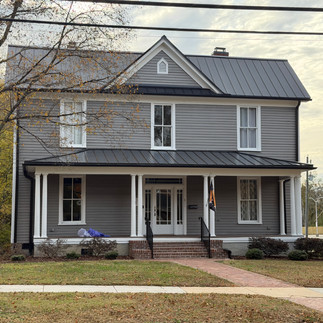November 2, 2025 -- To Durham And Back
- Lucian@going2paris.net

- 12 minutes ago
- 5 min read
Charlottesville
November 3, 2025
Yesterday was another wanderabout to Durham to watch the Blue Devils -- this time as they defeated the Toothy Birds 1-0 in a rainstorm.
Dillwyn, Virginia
Dillwyn is an incorporated town in Buckingham County, Virginia, United States. The population was 447 at the 2010 census.
Buckingham Branch Railroad
Buckingham Branch Railroad is a Class III short-line railroad operating over 275 miles of historic and strategic trackage in Central Virginia. Sharing overhead traffic with CSX and Amtrak, the company's headquarters are in Dillwyn, Virginia in the former Chesapeake and Ohio Railway (C&O) station, itself a historic landmark in the community.
Buckingham Branch Railroads' tracks are located in the heart of Central Virginia. The routing was largely constructed in the 19th century by several railroad companies. These include the Louisa Railroad, the Virginia Central Railroad, the state-owned Blue Ridge Railroad (with famous tunnels designed by state engineer Claudius Crozet and financed by the Virginia Board of Public Works), and the Covington and Ohio Railroad. All of those lines became part of Collis Huntington's Chesapeake and Ohio Railroad (later the Chesapeake and Ohio Railway) (C&O) in the 1870s, which connected the Chesapeake Bay with the valleys of the New River and Kanawha River, leading to the Ohio River Valley and thence the Mississippi River.
In the 1880s, Major James H. Dooley's Richmond and Allegheny Railroad was built along the James River along the former right-of-way of the James River and Kanawha Canal. It too became part of the C&O, offering a lower grade pathway for coal bound from the mountains to Newport News than the older line through Staunton, Crozet's Blue Ridge Tunnel complex, and Charlottesville. Diverging from the older line at JD Cabin just east of Clifton Forge, this became known as the James River line, rejoining the old Virginia Central tracks near Main Street Station at Richmond.
The short-line branch from Bremo Bluff on the James River line into Buckingham County transported kaolin clay from the unique and rare deposits of Willis Mountain, along with timber, quarried rock, and minor amounts of general freight.
As major railroads merged and consolidated in the late 20th century, many rail lines with low traffic were abandoned, spun off into short-line railroads, or became at risk for abandonment. With lower operating costs and personalized service to shippers, many of the short-lines were able to perpetuate rail service in areas where the Class 1 railroads could not operate profitably, even when subsidized by government entities. In 2021, the line between Doswell and Clifton Forge was acquired from CSX by the Commonwealth of Virginia as part of a broader program to expand passenger service. Buckingham Branch Railroad's operations would continue.
The Buckingham Branch was founded in 1989 by retired CSX railroader Robert E. Bryant. The company began with the acquisition of a 16-mile (26 km) long branch from the CSX Transportation's James River subdivision line near Bremo Bluff on the James River south to Dillwyn in Buckingham County. The interchange with CSX is at Strathmore yard, near the junction of the former Virginia Air Line Railway. Serving small industries and quarries, the BBRR began with one locomotive and a caboose, and was staffed by Bryant's family.
The line primarily operates EMD locomotives, including GP40 style engines as well as engines like GP16s that have since been rebuilt from other older models like GP7s that were initially purchased by the BB early on. For the most part, most engines are assigned a number composed of the railroad's initials and a new designated number they received upon joining the BB's engine roster. These numbers gradually rise in more or less incremental order with each individual engine, though some engines still retain their original paint schemes and numbers.
Virginia Scenic Railway
In August 2022, the BB began the operations of the heritage Virginia Scenic Railway (VSR) with round-trip excursions from Staunton, Virginia. Unlike many U.S. heritage operations, which operate on lightly used branch lines, the VSR trains share track with Amtrak and CSX operations. Around autumn of 2023, ex-Norfolk and Western 4-8-4 steam locomotive No. 611, visited the VSR to haul the weekend Shenandoah Valley Limited excursions between Goshen and Staunton. No. 611 hauled the excursion train forward to Staunton with two diesels pulling the train back up to Goshen since there was no turntable or wye at Staunton for No. 611 to be turned around. Multiple seating classes are offered, including Coach, Premium Coach, First Class, and Dome class. On July 9, 2025, it was announced that No. 611 would do the Shenandoah Valley Limited excursions again starting on September 26.
Oxford, North Carolina
Oxford is a town in Granville County, North Carolina, United States, with a population of 8,628 as of the 2020 census. It is the county seat of Granville County.

The town's history dates to 1761, when local legislator Samuel Benton built a plantation home and called it "Oxford." The legislature ordered the area around his plantation to be the seat of Granville County. The town was not incorporated until 1816.
The first Masonic orphanage for children in the United States was built in Oxford. It was originally established as St. John's College in 1858. The college ceased operations shortly after opening, however. In 1872 the community decided that the property should be repurposed to educate disadvantaged populations. In December 1873 the first residents were admitted to the Oxford Orphans Asylum, which is today known as the "Masonic Home for Children at Oxford."
In 1851 James H. Horner established Horner Military School,[10] which enrolled many young men from New York, Pennsylvania, Virginia, South Carolina and other states. Many of the students went on to become leaders in the United States government, such as James Crawford Biggs, Solicitor General under President Franklin D. Roosevelt at the inception of the New Deal. After the barracks were destroyed by a fire in 1913, the school relocated to Charlotte, North Carolina.
The Oxford Female College was established in 1850 by North Carolina Baptists. After suffering financial difficulties, the college was sold and became a private educational institution renamed "Oxford Female Seminary." In 1880 F. P. Hobgood took over leadership of the school, and it gained popularity under his leadership. The school closed in 1925, following Hobgood's death the previous year.
In 1883 the state legislature established the Colored Orphan Asylum in Oxford. Henry Plummer Cheatham, a former U.S. congressman (1889-1893), was appointed as superintendent in the early 1900s and led the institution for 28 years.
In 1970, Henry Marrow was shot and killed in Oxford. The killing resulted in a racial protest. The events were chronicled by Timothy Tyson in the book Blood Done Sign My Name (2004) and a 2010 movie with the same name.
A Confederate statue was erected in 1909 by the Granville Grays United Daughters of the Confederacy at a cost of $3000 and valued in 2009 at $1,327,792. The monument was erected in the courthouse square facing away from the courthouse. The base, constructed of granite from Warren County, is 27 feet (8.2 m) tall, and the bronze statue is 7 feet tall. The monument, a memorial to the Confederate veterans of Granville County that served in the Civil War in the Granville Grays Company D, 12th Regiment, was dedicated October 30, 1909. The statue had not arrived in time but the ceremony continued and the statue was placed at a later date.
Following the 1970 Oxford protests, the city moved the monument from the courthouse square to a site in front of the Richard H. Thornton Library. Since 2009, some activists had suggested moving it to an historic graveyard located down the street. In June 2020 the statue was removed and is currently in storage.



















































































Comments